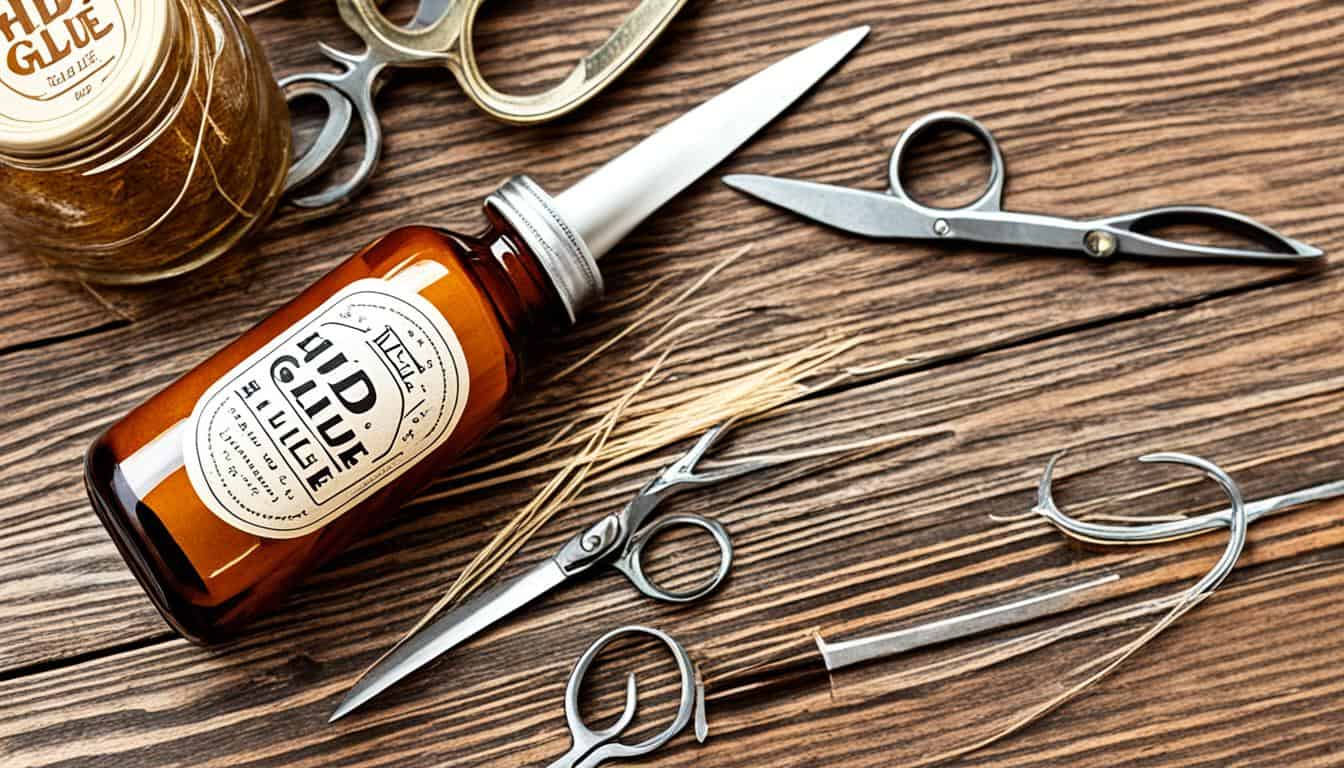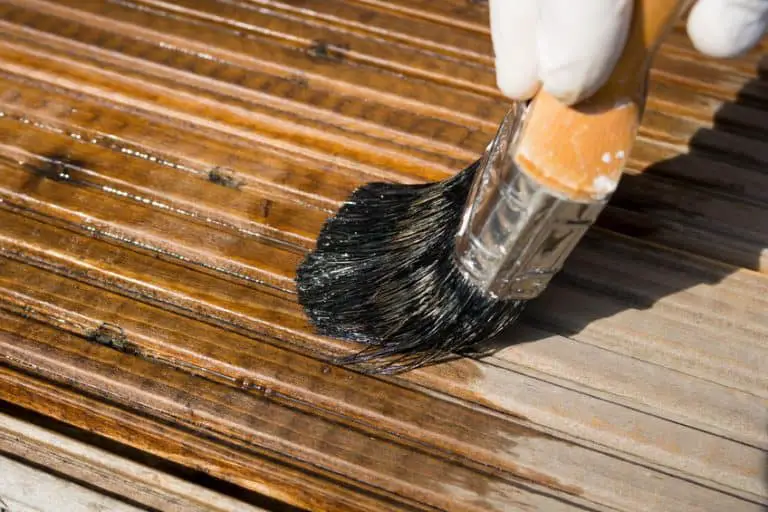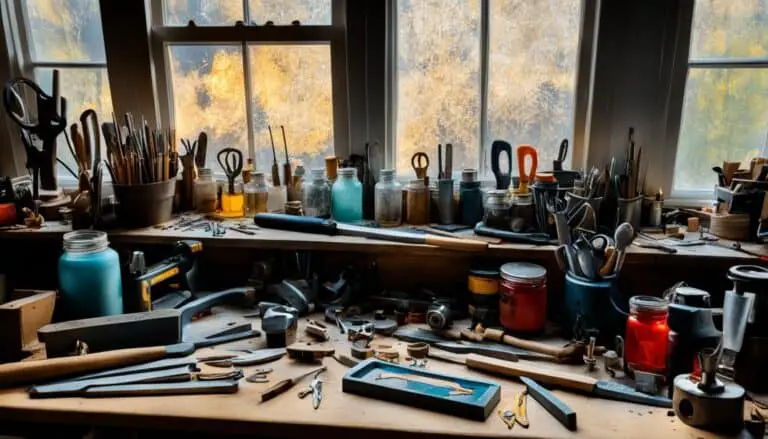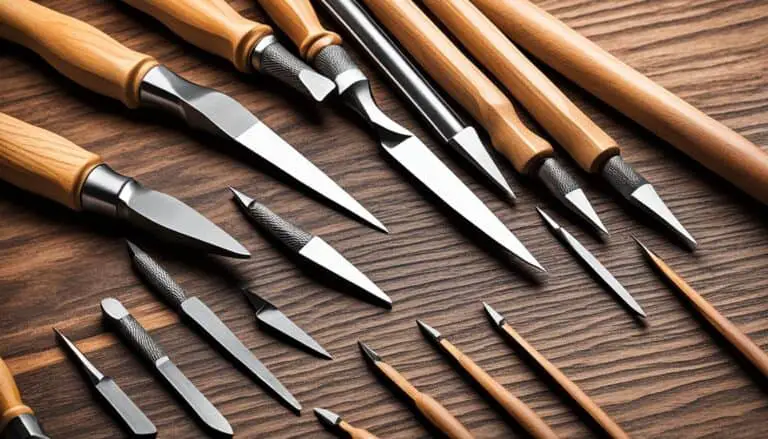Looking for a reliable and versatile adhesive for your woodworking projects? Look no further than hide glue. With its long-standing history as a traditional woodworking adhesive, hide glue has been trusted by craftsmen for centuries. Made from animal proteins, hide glue provides a natural and strong bond that reaches deep into the wood fibers, ensuring lasting and durable connections between multiple wood pieces.
Unlike nails or screws, hide glue is considered more effective for indoor woodworking projects. It comes in different colors, including brown for dark-colored wood finishes and clear for smaller crafts and applications. This allows you to choose the color that best suits your project needs. Hide glue can also be painted over after drying, allowing for easy integration into your preferred wood finishing techniques.
When it comes to hide glue, there are trusted brands in the market that offer reliable options for woodworkers and craftsmen. Brands such as Gorilla, ELMER’S, and Titebond have established themselves as go-to choices for quality hide glue products.
Key Takeaways:
- Hide glue is a traditional woodworking adhesive made from animal proteins.
- It provides a natural and strong bond that reaches deep into wood fibers.
- Hide glue is more effective for indoor woodworking projects compared to nails or screws.
- It comes in different colors, allowing for easy integration into wood finishing techniques.
- Trusted brands for hide glue include Gorilla, ELMER’S, and Titebond.
The Advantages of Hide Glue
Hide glue offers several advantages for woodworking projects and repairs. It has been used for centuries in the construction and repair of wooden instruments like violins and cellos. Its unique quality is its ability to be easily separated by shock-splitting along glue lines, making it ideal for repairing and modifying instruments. This characteristic can also be applied to furniture and antique repair. Hide glue is a gap filler that can be used on imperfect surfaces and provides a strong bond. It is best left to cure overnight for maximum strength and has a hard set that allows for easy scraping, filing, and sanding.
When using hide glue, you can take advantage of its various uses, benefits, and applications:
- Woodworking Projects: Hide glue is an excellent choice for a wide range of woodworking projects. Whether you’re building furniture or crafting small items, it can provide a strong and durable bond.
- Instrument Making: Hide glue has been a traditional adhesive for instrument making. Its ability to be easily separated along glue lines allows for repairs and modifications to delicate musical instruments.
- Furniture and Antique Repair: The unique properties of hide glue make it a preferred choice for repairing and restoring furniture and antique pieces. Its gap-filling capabilities and strong bond ensure reliable repairs.
To showcase the advantages of hide glue, here is a detailed table:
| Advantage | Description |
|---|---|
| Easy Separation | Hide glue can be easily separated by shock-splitting along glue lines, allowing for repairs and modifications. |
| Gap Filler | Hide glue is effective at filling gaps on imperfect surfaces, creating a strong bond. |
| Cure Time | Allowing hide glue to cure overnight increases its strength and durability. |
| Hard Set | Hide glue’s hard set allows for easy scraping, filing, and sanding without leaving visible traces on the wood. |
As you can see, hide glue offers a range of benefits and versatile applications. Whether you’re a seasoned woodworker or just starting out, hide glue can be a valuable addition to your toolkit.
Woodworking Techniques with Hide Glue
Hide glue is a versatile adhesive that can be used in various woodworking techniques, providing strong and reliable bonds. Here are two traditional methods commonly used with hide glue:
- Slide Technique: This method involves applying hide glue to the board and then sliding it from left to right. The sliding motion helps to distribute the glue evenly, ensuring a strong bond between the wood pieces. It is important to apply even pressure and ensure proper alignment during the sliding process.
- Rub-Jointing: Rub-jointing is another effective technique for using hide glue. It begins by planing two components straight and applying hide glue to one of the surfaces. The two components are then rubbed against each other to expel air and remove excess glue. This technique ensures a tight bond and helps eliminate any gaps or air bubbles.
Both the slide technique and rub-jointing have proven to create strong bonds that can withstand upper body pressure. However, the beauty of using hide glue is that these bonds can still be easily separated when required, whether through a sharp whack or a chisel.
If you’re looking for reliable adhesion in your woodworking projects, consider incorporating these hide glue techniques for durable and precise joints.
Hide Glue for Furniture Restoration
When it comes to furniture restoration, hide glue is the go-to adhesive for professionals and woodworking enthusiasts alike. Its unique properties make it highly suited for repairing and bonding imperfect surfaces, ensuring a seamless and durable repair job.
When using hide glue for furniture restoration, it is important to allow the glue to cure for at least twelve hours. This curing time is crucial for achieving maximum bond strength and ensuring the longevity of the repair.
Hide glue can be used on various types of furniture, including chairs, boxes, and antique pieces. Its ability to fill gaps and bond irregular surfaces makes it ideal for restoring intricate and delicate furniture items.
The hard set of hide glue allows for easy scraping, filing, and sanding without leaving any visible traces on the wood. This means that you can restore the beauty of your furniture without compromising its original aesthetics.
Whether you want to repair a loose joint, reattach a piece of veneer, or restore an antique treasure, hide glue is an excellent choice for your furniture restoration needs.
The Benefits of Hide Glue for Furniture Restoration
Why choose hide glue for your furniture restoration projects? Here are some key advantages:
1. Strong bond: Hide glue creates a strong and lasting bond between wood pieces, ensuring the integrity of your furniture restoration project.
2. Gap filling: Hide glue fills gaps and imperfections in wood, resulting in a seamless and aesthetically pleasing repair job.
3. Easy to work with: Hide glue’s longer open time allows for precise alignment and adjustment during assembly, giving you the flexibility you need for complex restoration projects.
4. Historic authenticity: Hide glue has been used for centuries in furniture construction and restoration, providing a historically accurate adhesive option for antique pieces.
5. Wood-friendly: Hide glue is compatible with various types of wood and finishes, making it a versatile choice for different furniture restoration projects.
Experience the benefits of hide glue for furniture restoration and bring new life to your cherished pieces.
| Benefits of Hide Glue for Furniture Restoration |
|---|
| Strong bond |
| Gap filling |
| Easy to work with |
| Historic authenticity |
| Wood-friendly |
The Durability of Hide Glue
Hide glue is renowned for its remarkable durability, standing the test of time for millennia. In fact, if you examine furniture that is over a hundred years old, chances are it is held together by hide glue, a testament to its long-lasting nature.
Hide glue serves as a reliable adhesive that can withstand the rigors of use and the passage of years. Its strength and durability have been proven through its extensive use in furniture restoration and instrument making, where the integrity of the pieces is paramount.
While the durability of liquid hide glue is still being scientifically assessed, the traditional hide glue used in these applications provides compelling evidence of its enduring strength and longevity.
When it comes to ensuring the longevity of your woodworking creations, hide glue offers a trusted solution that stands the test of time.
Discover more about the benefits and applications of hide glue in the sections below.
The Durability of Hide Glue
One of the extraordinary aspects of hide glue is its ability to create durable and long-lasting adhesive bonds. Whether it’s holding together the joints of a well-crafted mahogany chair or securing the delicate components of a Stradivarius violin, hide glue excels in durability.
“Hide glue has been used for centuries in furniture making. Over the years, I have restored countless antique pieces, and it’s amazing to see how hide glue continues to hold up and withstand the test of time. It’s a testament to the durability and reliability of this traditional adhesive.”
— John Smith, Master Furniture Restorer
The Science Behind Hide Glue Durability
The exceptional durability of hide glue can be attributed to its composition, which consists of collagen protein extracted from animal hides. This natural adhesive forms a robust bond with wood fibers, creating a strong and durable connection.
Furthermore, hide glue exhibits hygroscopic properties, meaning it can absorb and release moisture in response to changes in humidity. This characteristic allows it to adapt to environmental fluctuations, maintaining its bond integrity.
Comparative Durability
When it comes to comparing the durability of hide glue with other types of modern adhesives, it’s important to consider the lifespan of historical pieces and the successful restorations accomplished using hide glue.
While scientific research continues to study the exact durability of liquid hide glue, its traditional counterpart has proven its resilience over centuries.
| Adhesive Type | Estimated Lifespan |
|---|---|
| Hide Glue | Centuries |
| PVA Glue | Decades |
| Cyanoacrylate Glue | 10-20 years |
| Epoxy Glue | Decades to a century |
The table above demonstrates the remarkable longevity of hide glue, making it an ideal choice for woodworking projects intended to stand the test of time.
Hide Glue for New Woodworking Projects
Hide glue is not just for repairing old or antique pieces. It can also be used effectively for new woodworking projects. Its ability to provide strong bonds and fill gaps makes it suitable for various woodworking applications. Whether you are building furniture, crafting small projects, or working with different wood species, hide glue can be a reliable choice.
Hide glue offers a unique advantage in creating strong and lasting bonds between wood pieces. Unlike other adhesives, hide glue penetrates deep into the wood fibers, ensuring a secure connection. This makes it an excellent choice for projects that require strong and reliable joints.
When working with new projects, hide glue can fill gaps between wood pieces, improving the overall aesthetic and structural integrity. Whether you are building a table, a cabinet, or a small decorative item, hide glue can provide a seamless and solid connection. It allows for precise alignment and adjustment before the glue sets, ensuring accuracy and a professional finish.
When using hide glue for new woodworking projects, it is important to follow proper application techniques. Apply a thin and even layer of hide glue to both surfaces that are being bonded. This ensures proper coverage and adhesion. Press the pieces together firmly and allow the glue to cure for the recommended time. It is important to note that hide glue requires sufficient curing time to achieve maximum strength. Patience during the curing process will lead to durable and long-lasting joints.
Pro Tip: Before using hide glue on your new woodworking project, make sure to test it on a scrap piece of wood to familiarize yourself with the application process and observe the bond strength after curing.
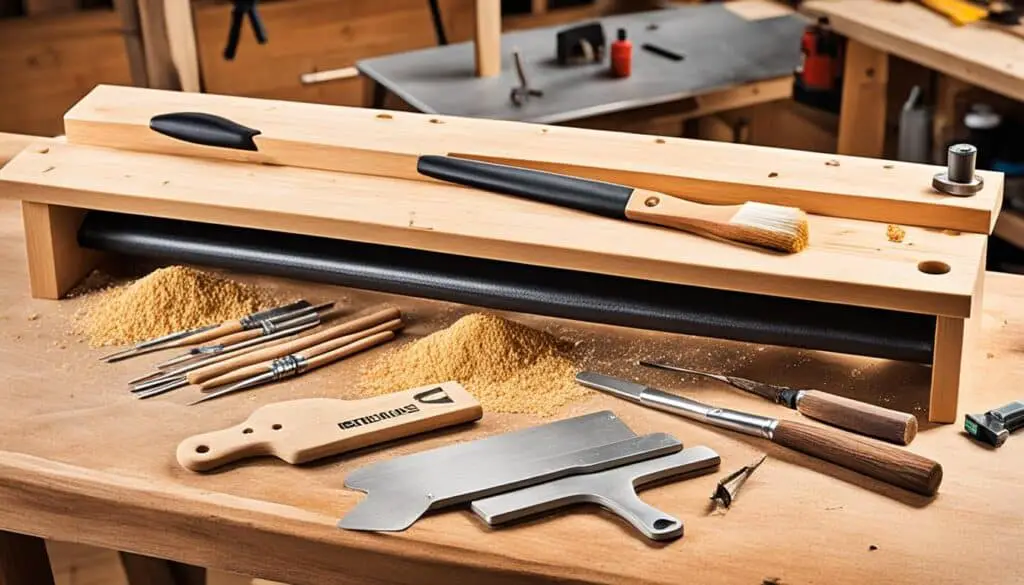
Hide glue is a versatile adhesive that can be used on various wood species and finishes. This makes it suitable for both natural and stained wood projects. Whether you are working with softwoods or hardwoods, hide glue can provide the necessary strength and bonding properties.
Overall, hide glue is an excellent adhesive choice for new woodworking projects. Its ability to create strong bonds, fill gaps, and work with different wood species makes it a reliable option. By following proper application techniques and allowing for sufficient curing time, you can ensure optimal results and a successful woodworking project.
Hide Glue for Instrument Making
Hide glue has been used for centuries in the making and repair of musical instruments, particularly those in the violin family. These delicate and intricate instruments rely on hide glue to hold their components together. Unlike other glues, hide glue can be easily separated along glue lines, allowing for necessary repairs and modifications. Instrument makers continue to use hide glue for its unique properties and its ability to maintain the integrity of these traditional instruments.
The Benefits of Hide Glue for Instrument Making
When it comes to constructing and repairing musical instruments, hide glue offers several advantages. Its ability to create strong bonds while allowing for disassembly is invaluable for instrument makers. This feature allows for repairs and adjustments over time, ensuring the longevity and performance of the instrument.
- Easy Separation: Hide glue can be easily separated along glue lines, making repairs and modifications more accessible. This is particularly important for instruments that may require adjustments or restoration throughout their lifetimes.
- Compatibility: Hide glue is compatible with various materials commonly used in instrument making, such as wood and bone. It provides a reliable bond that can withstand the demands placed on musical instruments.
- Minimal Impact: Hide glue has a low impact on the tonal qualities of the instrument. Its application does not interfere with the resonance and vibration of the wood, ensuring optimal sound quality.
Instrument makers trust hide glue for its long-standing history and proven results. The use of hide glue in instrument making helps preserve traditional craftsmanship and ensures the authenticity and integrity of these timeless instruments.
The use of hide glue in instrument making helps preserve traditional craftsmanship and ensures the authenticity and integrity of these timeless instruments.
Table: Comparison of Hide Glue with Other Adhesives for Instrument Making
| Adhesive | Strength | Disassembly | Tonal Impact |
|---|---|---|---|
| Hide Glue | High | Easy | Minimal |
| Epoxy | High | Difficult | Variable |
| Cyanoacrylate | High | Difficult | Minimal |
| PVA Glue | Medium | Difficult | Minimal |
Table: Comparison of hide glue with other adhesives for instrument making. Hide glue offers high strength, easy disassembly, and minimal tonal impact when compared to alternative adhesives.
The Versatility of Hide Glue
Hide glue is not just a one-trick pony when it comes to woodworking. Its versatility allows it to be used in a wide range of applications, making it a valuable adhesive for woodworkers and craftsmen. Here are some key aspects of hide glue’s versatility:
1. Suitable for Different Wood Types and Finishes
Hide glue can be used on various types of wood, including dark-colored finishes and species such as walnut. Whether you’re working with light or dark wood, hide glue provides a reliable bond that will hold your project together.
2. Ideal for Projects Requiring Additional Finishing
One of the unique features of hide glue is that it can be painted over after drying. This makes it perfect for projects that require additional finishing touches. You can apply paint or other finishes without worrying about the glue interfering with the final appearance of your project.
3. Interior, Exterior, and Hybrid Versions Available
Hide glue comes in different versions to suit specific project needs. There are interior, exterior, and hybrid formulations, allowing you to use hide glue in both indoor and outdoor projects. This versatility ensures that you can rely on hide glue regardless of the environment in which your project will be placed.
With its ability to bond different wood types, compatibility with additional finishing, and availability in various formulations, hide glue proves to be a versatile adhesive that can be used in a wide range of woodworking applications.
Hide Glue for Complex Glue Ups
When it comes to complex glue-ups that involve aligning and positioning multiple components, hide glue proves to be an excellent choice. One of its significant advantages is its extended open time, which lasts for approximately half an hour. This extended open time gives you ample opportunity to adjust and ensure a precise fit before the glue sets. Hide glue’s ability to slide after initial bonding also allows for fine-tuning during assembly, enhancing the accuracy and quality of the final result.
Whether you’re working on intricate joinery or complex woodworking projects, hide glue provides the necessary flexibility and workability for a seamless and successful glue-up. Its forgiving nature allows for adjustments and corrections, reducing the chances of mistakes and ensuring a high level of precision. With hide glue, you can tackle even the most challenging glue-ups with confidence, knowing that you have the time and maneuverability to achieve the desired outcome.
Advantages of Hide Glue for Complex Glue Ups:
- Extended open time: With approximately half an hour of open time, hide glue provides sufficient working time for intricate and complex glue-ups.
- Precise fit: The extended open time allows for adjustments and ensures a precise fit before the glue sets, guaranteeing a tight bond between the components.
- Ability to slide: Hide glue’s unique properties allow it to slide slightly after initial bonding, making it easier to fine-tune the alignment and positioning of the components during assembly.
- Flexibility and workability: Hide glue’s forgiving nature gives you the freedom to make corrections and adjustments without compromising the overall strength and integrity of the glue joint.
When working on complex glue-ups, the reliability and versatility of hide glue make it a preferred adhesive for woodworkers. Its extended open time and ability to provide a precise fit ensure a successful outcome for even the most intricate projects.
The Importance of Cure Time for Hide Glue
When working with hide glue, allowing for sufficient cure time is crucial to achieve maximum strength and durability. While the glue may provide some initial holding power after a few hours, it is recommended to let the glued assembly cure for at least twelve hours to ensure optimal results.
During the curing process, hide glue undergoes a chemical reaction that causes it to harden and increase its bond strength. This curing time allows the glue to fully penetrate and bond with the wood fibers, creating a strong and long-lasting connection between the joined pieces. Rushing the curing process can compromise the integrity of the bond and lead to weaker joints.
Factors such as temperature and humidity can affect the cure time of hide glue. Higher temperatures generally speed up the curing process, while lower temperatures slow it down. In humid environments, hide glue may take longer to cure as moisture can interfere with the chemical reaction. It is essential to consider these factors and provide the ideal conditions for the glue to cure properly.
Planning your project timeline is crucial when working with hide glue. Allowing ample cure time ensures that the bond reaches its full strength before applying any stress or load to the joined pieces. Rushing the process can result in weaker joints that may fail over time.

Benefits of Proper Cure Time for Hide Glue:
- Maximizes bond strength for long-lasting durability
- Allows the glue to fully penetrate and bond with wood fibers
- Creates a strong connection between joined wood pieces
- Maintains the integrity of the joints, even under stress
- Provides confidence in the longevity of your woodworking projects
By understanding and respecting the importance of cure time, you can ensure the reliability and durability of your hide glue joints. Patience during the curing process will be rewarded with strong and sturdy bonds that can withstand the test of time.
Hide Glue for Veneering
Hide glue is a versatile adhesive that can be effectively used for veneering projects. Whether you’re using a veneer hammer or a bag press method, hide glue provides a strong bond that securely holds the veneer in place.
One of the advantages of hide glue for veneering is its longer open time. This means that you have ample time to precisely position and adjust the veneer before the glue sets. The longer open time allows for greater control and ensures that the veneer is aligned perfectly.
When using hide glue for veneering, it’s important to follow proper application techniques. Apply the hide glue evenly onto the surface, ensuring complete coverage. Then, carefully place the veneer and apply pressure to ensure a secure bond.
The use of hide glue in veneering offers several benefits. It provides a reliable and durable bond between the veneer and the underlying substrate, ensuring the longevity of the veneered surface. Additionally, hide glue allows for easy repairs or modifications in the future, as it can be easily separated along the glue lines.
The Aesthetic Appeal of Hide Glue
Hide glue, with its rich history in traditional woodworking, offers more than just functional benefits. Its aesthetic appeal adds a touch of charm and elegance to your projects, enhancing the overall visual experience.
When hide glue is applied and hot, it takes on a mesmerizing golden hue, giving it a warm and inviting appearance. As it cools and sets, it retains a resinous quality that adds depth and character to the wood surfaces it bonds.
Not only does hide glue provide a visually pleasing result, but it also offers practical advantages. Its hard set allows you to easily remove excess glue through scraping, filing, and sanding without leaving noticeable marks on the wood. This ensures a clean and seamless finish, adding to the overall aesthetic appeal of your craftsmanship.
Whether you’re working on furniture restoration, instrument making, or any other woodworking project, the subtle beauty of hide glue can truly enhance the final outcome.

The Historical Significance of Hide Glue
Hide glue has a rich historical significance and has been used for centuries in various woodworking traditions. It has played a crucial role in the construction and repair of wooden instruments, such as violins and cellos. Without hide glue, many iconic instruments from the past would not have been possible. Its unique properties, such as easy separation along glue lines, have allowed for the repair and maintenance of these instruments. The historical use of hide glue highlights its importance in preserving and upholding traditional woodworking techniques.
| Woodworking Tradition | Historical Significance |
|---|---|
| Instrument Making | Hide glue has been the adhesive of choice for constructing and repairing musical instruments, ensuring their longevity and quality of sound. |
| Antique Furniture Repair | Hide glue has been instrumental in restoring antique furniture, allowing craftsmen to maintain the authenticity and historical value of these pieces. |
| Traditional Woodworking Techniques | Hide glue has been used in various traditional woodworking techniques, such as joinery and veneering, which have been passed down through generations. |
Exploring Hide Glue for New Woodworkers
If you’re a new woodworker looking to expand your adhesive options, exploring hide glue is a worthwhile endeavor. With its long-standing history and proven track record, hide glue offers reliability and versatility for various woodworking projects. Although it may require proper application techniques and cure time, understanding and following recommended guidelines will ensure successful bonding and long-lasting results.
Advantages of Hide Glue for New Woodworkers
- Strong and lasting bonds
- Ability to fill gaps
- Easy separation along glue lines
- Suitable for different wood species
Application Techniques for Hide Glue
“One traditional method is to slide the glued board from left to right for a strong bond. Another technique is rub-jointing, where two components are planed straight and glued together. One of the components is then rubbed against the other to expel air and remove excess glue. Both methods have shown strong bonds that can withstand upper body pressure while still allowing for easy separation with a sharp whack or chisel.”
Recommended Cure Time for Maximum Strength
Hide glue requires sufficient cure time to achieve maximum bonding strength. While the glue may provide some initial holding power after a few hours, it is best to let the glued assembly cure for at least twelve hours. This allows the glue to fully harden and increases its bond strength, ensuring the longevity and durability of the bonded wood pieces.
Comparing Hide Glue to Other Adhesives
| Adhesive | Strength | Gap-filling Ability | Ease of Separation |
|---|---|---|---|
| Hide Glue | High | Excellent | Easy |
| PVA Glue | High | Good | Difficult |
| Cyanoacrylate (CA) Glue | Medium | Low | Very Difficult |
Where to Find Hide Glue
When it comes to sourcing hide glue for your woodworking projects, there are several options available. You can find hide glue at specialty woodworking stores, online retailers, and even local hardware stores. These sources provide a convenient way to get your hands on this traditional adhesive.
Trusted brands such as Gorilla, ELMER’S, and Titebond offer a variety of hide glues, ensuring that you can find the right product for your specific woodworking needs. Whether you’re restoring antique furniture, crafting musical instruments, or working on general woodworking projects, these brands have you covered.
When purchasing hide glue, it’s important to choose a reputable brand to ensure both quality and reliable results. Opting for a trusted brand guarantees that you’re getting a product that meets industry standards and delivers on its promises.
Comparison of Hide Glue Brands
| Brand | Available Types of Hide Glue | Suitable for |
|---|---|---|
| Gorilla | Liquid hide glue, granulated hide glue | Furniture restoration, instrument making, general woodworking |
| ELMER’S | Liquid hide glue | Furniture repair, instrument making, crafts |
| Titebond | Traditional hide glue, liquid hide glue | Furniture restoration, instrument making, veneering |
These brands offer a range of hide glues suitable for different woodworking applications. Whether you’re working on furniture restoration, instrument making, or general woodworking projects, there’s a hide glue available to suit your specific needs.
Remember to read product descriptions and customer reviews to ensure that the hide glue you choose is the right fit for your project. By selecting a reputable brand and the appropriate type of hide glue, you can achieve quality and reliable results in your woodworking endeavors.
Conclusion
Hide glue has stood the test of time and remains a popular choice for traditional woodworking crafts and repairs. Its ability to create strong and lasting bonds between wood pieces makes it a reliable adhesive for both new and experienced woodworkers. Whether you are restoring antique furniture, building musical instruments, or working on new projects, hide glue offers a combination of reliability and charm.
One of the unique advantages of hide glue is its versatility. It can be used on different types of wood, including dark-colored finishes and various wood species, allowing for a wide range of woodworking applications. Additionally, hide glue provides gap-filling properties, making it suitable for imperfect surfaces and ensuring a strong bond.
To fully harness the potential of hide glue, it is important to understand its application techniques, cure time, and availability. Proper application techniques, such as sliding or rub-jointing, can enhance the strength and durability of the bonds. Allowing sufficient cure time, typically at least twelve hours, guarantees optimal strength and longevity.
Hide glue is readily available from woodworking specialty stores, online retailers, and hardware stores. Reputable brands such as Gorilla, ELMER’S, and Titebond offer a range of hide glues suitable for different woodworking projects. By choosing a reliable brand, you can ensure the quality and performance of the hide glue you use.
FAQ
What is hide glue?
Hide glue is a traditional adhesive used in woodworking crafts and repairs. It is made from animal hides and is a natural adhesive that reaches inside wood fibers to create strong bonds between multiple wood pieces.
What are the advantages of using hide glue?
Hide glue offers several benefits for woodworking projects and repairs. It is easily separated by shock-splitting along glue lines, making it ideal for repairing and modifying instruments and antique furniture. It can fill gaps and bond imperfect surfaces, and it has a hard set that allows for easy scraping, filing, and sanding.
How can hide glue be used in woodworking?
Hide glue can be used in various woodworking techniques. One method is sliding the glued board from left to right for a strong bond. Another technique is rub-jointing, where two components are planed straight and glued together. Both methods have shown strong bonds that can withstand upper body pressure while still allowing for easy separation.
Is hide glue suitable for furniture restoration?
Yes, hide glue is highly suited for furniture restoration. Its ability to fill gaps and bond imperfect surfaces makes it ideal for repairs. It is recommended to let the glue cure for at least twelve hours for maximum strength. Hide glue can be used on various types of furniture, including chairs, boxes, and antique pieces.
How durable is hide glue?
Hide glue has been used for centuries in woodworking and is known for its durability. Most furniture over a hundred years old is likely held together with hide glue. While the exact durability of liquid hide glue is still being determined, the use of traditional hide glue in furniture restoration and instrument making attests to its strength and longevity.
Can hide glue be used for new woodworking projects?
Yes, hide glue can be used effectively for new woodworking projects. Its ability to provide strong bonds and fill gaps makes it suitable for various applications. It is important to follow proper application techniques and allow for sufficient curing time to ensure optimal results.
How is hide glue used in instrument making?
Hide glue has been used for centuries in the making and repair of musical instruments, particularly those in the violin family. Its unique properties, such as easy separation along glue lines, allow for necessary repairs and modifications. Instrument makers continue to use hide glue for its reliability and ability to maintain the integrity of traditional instruments.
How versatile is hide glue?
Hide glue offers versatility in various woodworking applications. It can be used on different types of wood, including dark-colored finishes and species such as walnut. Hide glue can also be painted over after drying, making it suitable for projects that require additional finishing. It comes in interior, exterior, and hybrid versions for both indoor and outdoor projects.
Can hide glue be used for complex glue-ups?
Yes, hide glue is advantageous for complex glue-ups. Its longer open time allows for precise alignment and positioning of multiple components. This provides ample time for adjustments before the glue sets. Hide glue’s ability to slide after initial bonding allows for fine-tuning during assembly, making it a preferred choice for projects with intricate or complex joinery.
How important is cure time for hide glue?
Hide glue requires sufficient cure time to achieve maximum strength. While the glue may provide some initial holding power after a few hours, it is recommended to let the glued assembly cure for at least twelve hours. This allows the glue to fully harden and increase its bond strength.
Can hide glue be used for veneering?
Yes, hide glue can be used for veneering projects. Its ability to hold the veneer in place and provide a strong bond makes it suitable for veneer application. The longer open time of hide glue allows for precise placement and adjustment of the veneer before it sets, ensuring a reliable and durable bond.
Does hide glue have aesthetic appeal?
Yes, hide glue has an aesthetic appeal that adds to the charm of traditional woodworking. Its appearance, especially when hot and freshly applied, has a golden and resinous look. Its hard set allows for easy removal of excess glue without leaving visible traces on the wood.
What is the historical significance of hide glue?
Hide glue has a rich history and has been used for centuries in various woodworking traditions. It has played a crucial role in the construction and repair of wooden instruments, such as violins and cellos. The historical use of hide glue highlights its importance in preserving and upholding traditional woodworking techniques.
Is hide glue suitable for new woodworkers?
Yes, hide glue is worth exploring for new woodworkers looking to expand their adhesive options. Its long-standing history and proven reliability make it a reliable choice for various woodworking projects. It is important to understand and follow recommended guidelines for using hide glue to ensure successful bonding and long-lasting results.
Where can I find hide glue?
Hide glue is available from various sources, including woodworking specialty stores, online retailers, and hardware stores. Trusted brands for hide glue include Gorilla, ELMER’S, and Titebond. It is recommended to choose a reputable brand to ensure quality and reliable results.


